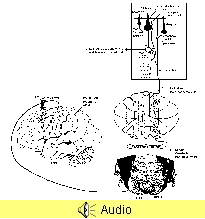Functions
Lat.
Zone
 As presented earlier, the SMA and PM send
planning information to the primary motor cortex (motor
I, MI or area 4). NOW THE INFORMATION GETS INTO THE
CORTICOSPINAL SYSTEM (see illustration on opposite
page). Upon receiving these instructions MI puts together
more specific ("nuts and bolts") instructions that
"micromanage" the movement by telling individual muscles in
the hand, arm and trunk what to do
As presented earlier, the SMA and PM send
planning information to the primary motor cortex (motor
I, MI or area 4). NOW THE INFORMATION GETS INTO THE
CORTICOSPINAL SYSTEM (see illustration on opposite
page). Upon receiving these instructions MI puts together
more specific ("nuts and bolts") instructions that
"micromanage" the movement by telling individual muscles in
the hand, arm and trunk what to do
 Information from the
primary motor cortex is conveyed to cells in the spinal cord
via the corticospinal tract. This information that is
sent to the spinal cord from the primary motor cortex is
also conveyed to the pontine grey (corticopontine fibers)
and in turn to the intermediate zone of the
cerebellum. As the movement to reach and grasp the apple
evolves, the dorsalspinocerebellar and cuneocerebellar
pathways convey what the muscles are really doing as they
reach out and grasp the apple. This incoming sensory
information (what the muscles are actually doing) is then
compared to the MI-corticospinal signal (conveyed to the
intermediate zone via the corticopontine-pontocerebellar
fibers) regarding what the muscles are supposed to be
doing. If necessary, corrections are conveyed from the
intermediate zone, via nucleus interpositus, to the red
nucleus (rubrospinal tract, fast corrections) and MI
(corticospinal tract).
Information from the
primary motor cortex is conveyed to cells in the spinal cord
via the corticospinal tract. This information that is
sent to the spinal cord from the primary motor cortex is
also conveyed to the pontine grey (corticopontine fibers)
and in turn to the intermediate zone of the
cerebellum. As the movement to reach and grasp the apple
evolves, the dorsalspinocerebellar and cuneocerebellar
pathways convey what the muscles are really doing as they
reach out and grasp the apple. This incoming sensory
information (what the muscles are actually doing) is then
compared to the MI-corticospinal signal (conveyed to the
intermediate zone via the corticopontine-pontocerebellar
fibers) regarding what the muscles are supposed to be
doing. If necessary, corrections are conveyed from the
intermediate zone, via nucleus interpositus, to the red
nucleus (rubrospinal tract, fast corrections) and MI
(corticospinal tract).
The computations occurring in the intermediate zone involve mossy fiber barrages associated with the pontocerebellar fibers carrying information from the hand and arm region of MI about the intended movement. This information is somehow "compared" with information conveyed via the dorsal and cuneocerebellar fibers (what is really happening to the muscles). This comparing will happen in the hand and arm part of the anterior and posterior lobes. The inputs need to be sharpened temporally (feedback inhibition via Golgi cells) and spatially (feedforward inhibiton via basket cells. The Purkinje cell signals being sent to interpositus mix with the direct signals from mossy and climbing fibers, and an ongoing correction signal is sent to the red nucleus (quick adjustments via the rubrospinal tract) and back to MI (slower adjustments).
Lesions of the intermediate zone and nucleus interpositus are thought to result in similar deficits as those in the lateral zone and the dentate. Such lesions interrupt the ability of the cerebellum to correct movements once they are started. In contrast to cells in the dentate nucleus, cell in the interpositus fire after the movement has begun. Such cells are involved in updating ongoing movements versus planning such movements (dentate).